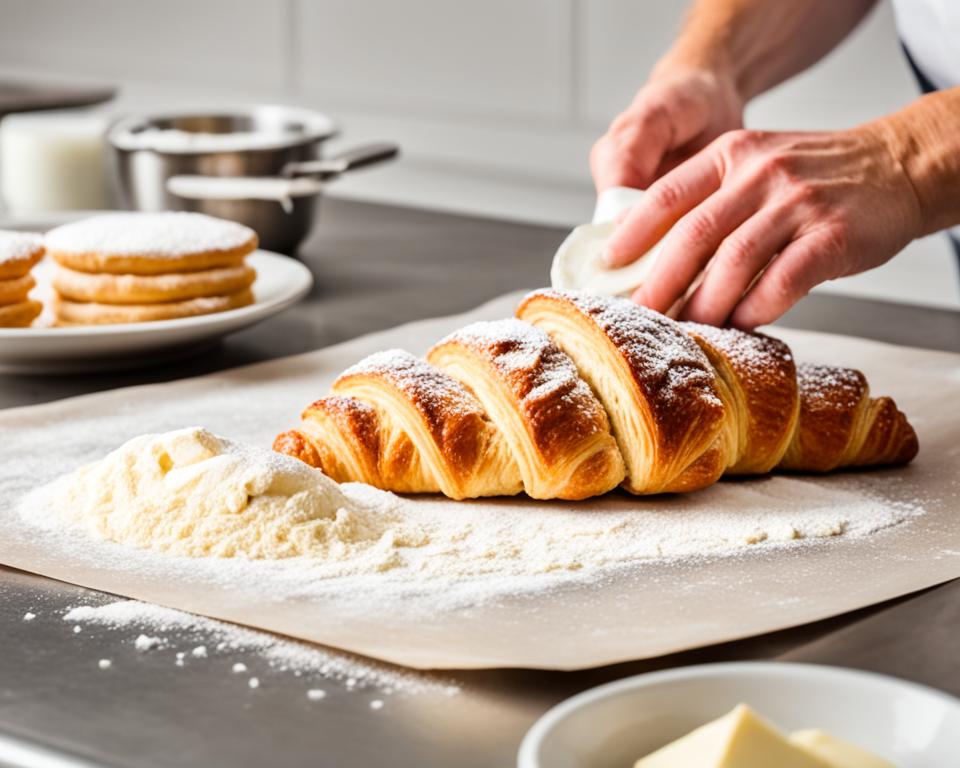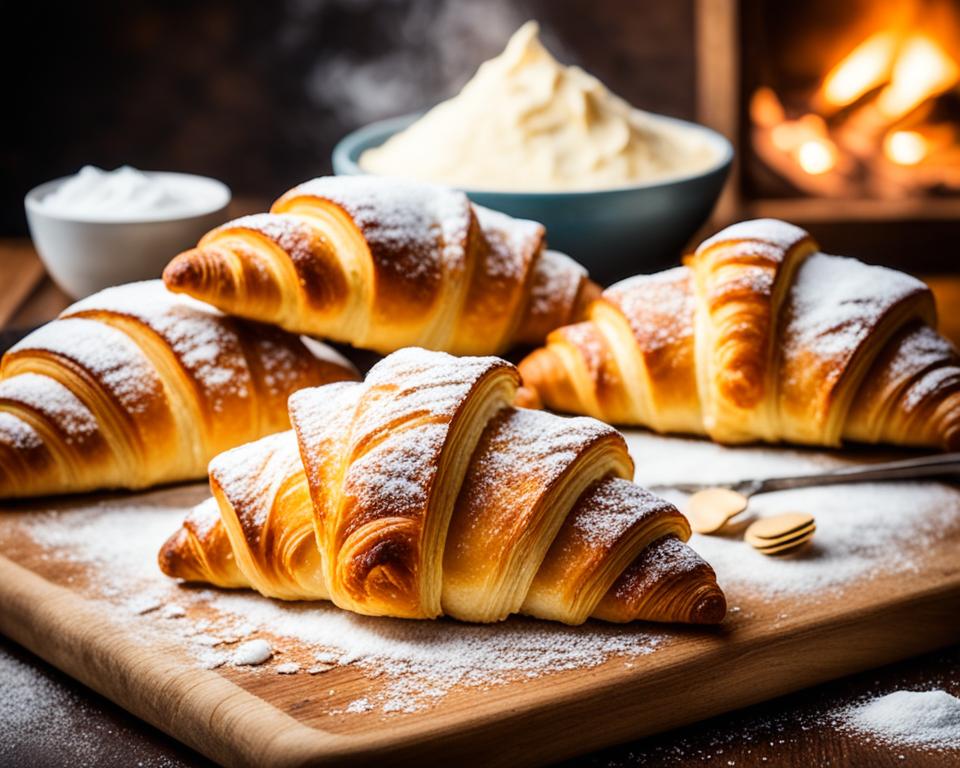Welcome to our flaky croissant recipe! If you’ve ever craved the buttery, light, and flaky layers of a bakery croissant, you’re in luck. Our homemade croissants have received rave reviews from readers who claim they’re even better than what you can find at your local bakery. Get ready to impress your family and friends with these delicious treats!
There’s nothing quite like biting into a freshly baked croissant with its golden, flaky exterior and tender, buttery interior. But have you ever wondered what makes croissants so irresistibly flaky? The secret lies in the combination of butter and the rolling and folding technique used in the dough.
Making croissants at home may sound daunting, but it’s not necessarily difficult. With the right instructions and a little bit of patience, you can achieve the same bakery-quality croissants in your own kitchen. So, let’s dive into the important steps and tips to ensure your success!
Key Takeaways:
- Our flaky croissant recipe produces buttery, light, and flaky layers that rival those from a bakery.
- The combination of butter and the rolling and folding technique creates the desired flakiness in croissants.
- While making croissants at home requires time and patience, it is achievable for home bakers.
- Important steps include preparing the dough, laminating with butter, shaping, proofing, and baking.
- Quality ingredients, such as European butter, can enhance the flavor and texture of your croissants.
What Makes Croissants So Flaky
The secret to creating the perfect flaky croissant lies in two essential elements: butter and the rolling and folding technique. When these elements come together, they produce a pastry that is light, airy, and incredibly delicious.
Butter: One of the key ingredients in a croissant is butter. It plays a crucial role in achieving the flakiness that we all love. As the croissants bake, the butter melts and creates steam. This steam, trapped within the layers of dough, expands and creates pockets of air, resulting in the flaky texture we associate with croissants.
| Key Ingredient | Role |
|---|---|
| Butter | Creates steam when baked, contributing to flaky layers |
Rolling and Folding: The rolling and folding technique used in croissant dough preparation is another critical factor in achieving flakiness. The dough is rolled out into a thin sheet, and then layers of butter are spread onto the dough. The dough is then folded multiple times, creating even more layers. This process, known as lamination, contributes to the countless flaky layers that make up a croissant.
Remember, achieving flakiness in croissants is a combination of high-quality butter and meticulous rolling and folding. These processes work together to create the delicate layers that give croissants their signature texture.
Unleashing the Potential: Butter and Layers
Let’s take a closer look at how the combination of butter and the rolling and folding technique brings the flakiness to life in a croissant:
- Butter: As the croissants bake, the butter melts, releasing moisture and creating steam. This steam gets trapped within the layers of dough, causing the dough to rise and creating the flaky texture.
- Rolling and Folding: By repeatedly rolling and folding the dough, layer upon layer of butter is incorporated. This process creates even more pockets of steam when baked, resulting in the light, airy, and flaky croissant we all crave.
It’s truly a symphony of buttery indulgence and careful technique!
Is It Hard To Make Croissants At Home
Making croissants at home requires some time and patience, but it is not necessarily difficult. The process involves preparing the dough, rolling and folding with the butter, and refrigerating the dough. While it may take practice to perfect the technique, it is achievable for home bakers with the right instructions and a willingness to invest time.
| Difficulty Level | Process |
|---|---|
| Intermediate | Preparing the dough |
| Rolling and folding with butter | |
| Refrigerating the dough | |
| Practice and patience |
“Making croissants at home can be a rewarding experience. While the process may seem daunting at first, with each attempt, you’ll gain confidence and improve your technique. Don’t get discouraged if your first batch doesn’t turn out perfect – practice makes perfect!”
If you’re new to baking or have limited experience working with yeast-based dough, making croissants may present some challenges. However, with the right instructions and a willingness to invest time and effort, homemade croissants can become a delightful addition to your baking repertoire.
By following a step-by-step guide and understanding the key techniques involved, such as rolling and folding the dough, you’ll be well on your way to creating flaky, buttery croissants right in your own kitchen.
Remember, the first few attempts may not yield the same results as a professional bakery, but with practice, you’ll be able to achieve impressive results. Don’t be afraid to experiment with different fillings or variations to personalize your croissants and make them truly unique.
Important Steps To Make Croissants From Scratch
When it comes to making croissants from scratch, there are several important steps you need to follow to achieve that perfect flaky texture and buttery flavor. Let’s take a closer look at each step:
1. Preparing the Croissant Dough
The first step is to prepare the croissant dough. This involves mixing together the necessary ingredients, including flour, yeast, sugar, salt, milk, and an egg. The dough is then kneaded until smooth and elastic.
2. Laminating the Dough with Butter
Lamination is a crucial step in creating those beautiful layers in croissants. To laminate the dough, a block of butter is folded into the dough and rolled out. This process is repeated multiple times to create layers of butter between the dough, resulting in that flaky texture.
3. Refrigerating the Dough
After laminating the dough, it’s important to refrigerate it. This helps relax the gluten and allows the dough to rest, which contributes to the final texture. It also chills the butter, ensuring it doesn’t melt during the subsequent rolling and folding steps.
4. Rolling and Folding
Rolling and folding the dough is another crucial step in creating those distinct layers in croissants. The dough is rolled out and folded multiple times, which creates even more layers and contributes to the desired flakiness.
5. Proofing the Shaped Croissants
Once the dough has been rolled and folded, it’s time to shape the croissants. This involves cutting the dough into triangles and rolling them into the iconic crescent shape. The shaped croissants are then left to proof, allowing them to rise slightly before baking. Proofing gives the croissants their light and airy texture.
6. Baking the Croissants
The final step is baking the croissants to golden perfection. The croissants are placed in a preheated oven and baked until they turn golden brown and develop a crisp exterior. The result is a batch of freshly baked croissants with a flaky exterior and a buttery, tender interior.
By following these important steps, you’ll be able to make delicious croissants from scratch that rival those from your favorite bakery. Now, let’s move on to the ingredients you’ll need for this recipe.
Everything You Need (Only A Few Ingredients!)
The homemade flaky croissant recipe requires only a few basic ingredients that you likely already have in your pantry. These include:
- All-purpose flour
- Unsalted butter
- Yeast
- Sugar
- Salt
- Milk
- An egg
Using quality ingredients, such as European butter, can enhance the flavor and texture of the croissants. When selecting the ingredients for your homemade croissants, opt for unsalted butter to have control over the amount of salt in the dough and all-purpose flour for its versatility and ability to create the desired flaky layers.
Now let’s take a closer look at how these simple ingredients come together to create a batch of delicious homemade croissants.
Tips For Success
Follow these key tips to ensure success with this flaky croissant recipe:
- Plan ahead: Before starting the recipe, make sure to plan ahead and allow the dough to refrigerate overnight. This resting period allows the flavors to develop and the dough to rest, resulting in a better final product. Your patience will be rewarded with perfectly flaky croissants.
- Use good butter: The quality of butter you use can greatly impact the flavor and texture of your croissants. Choose a high-quality butter with a high butterfat content. This will contribute to the rich, buttery taste that makes croissants so irresistible.
- Refrigerate the dough: After each round of rolling and folding, refrigerate the dough. This step is crucial in preventing the butter from melting and maintaining the integrity of the layers. Consistently refrigerating the dough helps achieve the flaky texture that is characteristic of a perfectly baked croissant.
By following these croissant tips, you’ll be on your way to baking the best flaky croissants of your life.

| Tips for Success: | |
|---|---|
| Plan ahead: | Allow the dough to refrigerate overnight. |
| Use good butter: | Choose high-quality butter with a high butterfat content. |
| Refrigerate the dough: | Consistently refrigerate the dough after each rolling and folding. |
Prepare
Preparing the croissant dough is the first step in creating your homemade flaky croissants. Follow these instructions to ensure a delicious final result:
- Gather all the necessary ingredients for the dough, including all-purpose flour, unsalted butter, yeast, sugar, salt, milk, and an egg.
- In a large mixing bowl, combine the flour, yeast, sugar, and salt. Mix well.
- Add the milk and beaten egg to the dry ingredients. Stir until a sticky dough forms.
- Transfer the dough onto a lightly floured surface and knead it for about 5 minutes until it becomes smooth and elastic.
- Shape the dough into a ball and place it in a greased bowl. Cover the bowl with plastic wrap and let the dough rise in a warm place for about 1 hour or until it doubles in size.
- Once the dough has risen, gently punch it down to release any air bubbles. Divide the dough into two equal portions.
- Shape each portion into a rectangle and wrap them tightly in plastic wrap.
- Refrigerate the dough overnight to allow the flavors to develop and the gluten to relax. This overnight rest will result in a better final product.
Now that you have prepared the dough and let it refrigerate overnight, you are ready to continue with the next steps of the croissant making process. The following sections will guide you through laminating the dough, shaping the croissants, and finally baking them to flaky perfection.
“The night of refrigeration is crucial to achieve the best flavor and texture in your homemade croissants.”
Make and laminate the Dough
Making and laminating the croissant dough is a crucial step in achieving that perfect flakiness. Follow these steps to prepare the dough:
Mix the dough ingredients
Start by combining the dough ingredients: all-purpose flour, yeast, sugar, salt, milk, and an egg. Knead the ingredients together until a smooth dough forms. This will provide the base for your delicious croissants.
Create a butter square
To create those beautiful layers, you’ll need to prepare a butter square. Mix butter and flour together until well combined. This will help distribute the butter evenly throughout the dough, resulting in a flaky texture.
Rolling and folding
Now comes the fun part: rolling and folding the dough. Roll out the dough into a large rectangle, ensuring it is thin and even. Then, place the butter square in the center of the dough. Fold the dough over the butter square, sealing it completely. Roll out the dough again, and fold it in thirds, like a letter. Repeat this process several times, allowing the dough to rest in the refrigerator between each fold. The rolling and folding create layers of butter within the dough, giving your croissants that desired flakiness.
Remember, the key to achieving those perfect layers is to be patient and give the dough enough time to rest and chill in the refrigerator. This will allow the butter to solidify and create distinct layers during baking.
Now that your croissant dough is properly prepared and laminated, it’s time to move on to the next steps. In the following section, we’ll discuss how to refrigerate the dough and why it’s an important part of the process.
Refrigerate the Dough
After the final turn and laminating of the dough, it is time to give it a rest in the refrigerator. This step is crucial to ensure the success of your flaky croissants. By refrigerating the dough overnight, you allow it to rest and chill, which allows the gluten to relax and the flavors to develop.
The overnight rest in the refrigerator also helps in preventing the butter from melting during the shaping and baking process. You see, when the butter melts too quickly in the oven, it can compromise the flakiness of the croissants.
To refrigerate the dough, securely wrap it in plastic wrap or place it in an airtight container. Make sure it is well sealed to prevent any air or odors from seeping in. Then, place it in the coldest part of your refrigerator, usually the bottom shelf.
Allowing the dough to rest and chill overnight not only improves the texture and flavor but also makes the dough easier to work with the next day. It becomes more pliable and easier to roll out, ensuring that you achieve those beautiful, flaky layers in your croissants.
In the meantime, take a moment to appreciate your progress and ready yourself for the exciting next steps in the croissant-making journey.
| Refrigerate the Dough | |
|---|---|
| Benefits | Allowing the dough to rest and chill: |
| – Helps the gluten relax | |
| – Develops the flavors | |
| – Prevents butter melting | |
| Method | 1. Securely wrap the dough in plastic wrap or place it in an airtight container |
| 2. Refrigerate the dough overnight in the coldest part of your refrigerator |
Now that your dough is chilling in the refrigerator, it’s time to get some well-deserved rest yourself. Tomorrow, you’ll be ready to roll out the dough, shape your croissants, and embark on the final steps towards your homemade flaky croissant success.
Rolling the Croissants and the Final Proof
Now that your dough has properly chilled, it’s time to roll it out and shape the croissants. This step is essential for achieving the flaky texture and beautiful layers that make croissants so irresistible.
Start by rolling the dough out into a large rectangle on a lightly floured surface. You want the dough to have a thickness of about 1/4 inch (0.6 cm). Take your time and roll gently, ensuring that the dough maintains its shape.
Once you have the desired rectangle, use a sharp knife or a pizza cutter to cut the dough into triangles. Begin at the wide end of the rectangle and make diagonal cuts towards the opposite side. Each triangle should be approximately 7-8 inches (18-20 cm) in length.
Note: Remember to work quickly during this process to prevent the dough from becoming too warm. If the butter begins to melt, the layers won’t be as distinct, resulting in a less flaky croissant.
After shaping the triangles, it’s time for the final proofing. This step allows the croissants to rise slightly before baking, giving them a light and airy texture.
Place the shaped croissants on a baking sheet lined with parchment paper, leaving some space between each one to allow for expansion. Cover the tray with a clean kitchen towel and let the croissants proof at room temperature for about 1-2 hours, or until they have visibly puffed up.
Pro tip: To ensure a successful final proof, find a warm and draft-free spot in your kitchen. You can even create a warm environment by placing the tray near a preheating oven or in a slightly warmed oven with the door cracked open.
During the final proof, the yeast in the dough will become active, causing the croissants to rise and develop a lovely lightness. This is the last opportunity for the dough to expand before baking, so it’s an important step in achieving those coveted flaky layers.
| Step | Description |
|---|---|
| 1 | Roll out the chilled dough into a large rectangle |
| 2 | Cut the dough into triangles |
| 3 | Place the shaped croissants on a baking sheet lined with parchment paper |
| 4 | Cover the tray with a kitchen towel and let the croissants proof at room temperature for 1-2 hours |
Bake and Enjoy the Croissants
After all the preparation and hard work, it’s finally time to bake your homemade croissants and savor their irresistible aroma. Baking is the final step in the process, where the magic happens, transforming the dough into golden, flaky delights.
To achieve that perfect crisp exterior, start by preheating your oven to a high temperature. This initial blast of heat will help create the desired crispy texture on the outside of the croissants. Then, lower the temperature slightly to ensure thorough baking and to prevent the croissants from burning.
Place your freshly shaped croissants on a baking sheet, making sure to leave enough space between them for expansion. As they bake, the layers of butter within the dough will melt, creating pockets of steam that will further contribute to their flakiness.
While waiting for the croissants to bake, your kitchen will be filled with an irresistible aroma that will have you eagerly anticipating the moment they are ready to come out of the oven. The scent of freshly baked croissants is truly a delight for the senses.
Once the croissants are beautifully golden brown and have a nice crunch on the outside, carefully remove them from the oven. Allow them to cool for a few minutes, but resist the temptation to wait too long. For the best flavor and texture, enjoy your croissants while they are still warm and freshly baked.
Indulge in the crisp exterior and tender, buttery layers that you have worked so hard to create. Whether you choose to enjoy them plain or with a spread of your favorite jam, these homemade croissants are bound to impress and satisfy.
So gather your loved ones, pour a cup of coffee, and savor the delightful experience of enjoying freshly baked croissants made with your own hands. The satisfaction and joy of achieving this culinary masterpiece are truly unparalleled.
Conclusion
Making homemade flaky croissants is a delightful and fulfilling baking venture that will reward you with scrumptious, buttery pastries. Although the process may demand some time and patience, the end result is undeniably worth it. With the best croissant recipe provided and the helpful tips, you can confidently embark on creating your own batch of perfect, flaky croissants right in the comfort of your own kitchen.
There’s nothing quite like the sense of accomplishment that comes from producing these delectable treats from scratch. And the taste? Irresistibly divine.
So, indulge your passion for homemade baking and treat yourself to the flaky croissants you’ve been dreaming of. With every golden, buttery bite, you’ll savor the magic of these homemade delights. Get started today and enjoy a slice of culinary heaven with these homemade flaky croissants.
FAQ
What makes croissants so flaky?
The combination of butter and the rolling and folding technique used in the dough creates flaky layers. The butter creates steam when baked, resulting in flaky layers, and the dough is rolled and folded multiple times to create even more layers.
Is it hard to make croissants at home?
While making croissants at home requires time and patience, it is achievable with the right instructions and a willingness to invest time. It may take practice to perfect the technique, but the end result is worth it.
What are the important steps to make croissants from scratch?
The important steps include preparing the dough, laminating the dough with butter, refrigerating the dough, rolling and folding, proofing, shaping, and finally baking. Each step contributes to the final flaky texture and buttery flavor of the croissants.
What are the ingredients needed to make croissants?
The croissant recipe requires all-purpose flour, unsalted butter, yeast, sugar, salt, milk, and an egg. Using quality ingredients, such as European butter, can enhance the flavor and texture of the croissants.
What are some tips for successful croissants?
Some important tips for successful croissants include planning ahead and allowing the dough to refrigerate overnight, using good quality butter with a high butterfat content, and consistently refrigerating the dough after each rolling and folding to prevent the butter from melting.
How do you prepare the croissant dough?
To prepare the croissant dough, you mix the dough ingredients, create a butter square by mixing butter and flour, and then roll and fold the dough to incorporate the butter into every layer. This process is repeated multiple times to create the desired flaky texture.
Why is it important to refrigerate the dough?
Refrigerating the dough overnight allows the dough to rest, the butter to chill, and the flavors to develop. It also prevents the butter from melting during the shaping and baking process, resulting in flakier croissants.
How do you shape the croissants?
Once the dough is properly chilled, you roll it out into a large rectangle and then cut it into triangles to shape the croissants. The shaped croissants then undergo a final proofing, allowing them to rise slightly before baking.
How do you bake and enjoy the croissants?
The croissants are baked at a high temperature initially to create a crisp exterior and then the temperature is lowered to ensure thorough baking. Enjoy the freshly baked croissants on the day they are made for the best flavor and texture.




